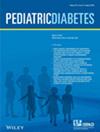小儿急性胰腺炎指数入院患者胰岛自身免疫率高
IF 3.9
3区 医学
Q2 ENDOCRINOLOGY & METABOLISM
引用次数: 0
摘要
介绍。急性胰腺炎后糖尿病的潜在病理生理学尚不清楚,儿童急性胰腺炎后发生糖尿病的总体风险尚不清楚。我们研究的目的是描述儿童患者在急性胰腺炎指数病例后一年内胰岛细胞自身免疫和异常葡萄糖检测的频率。材料与方法。数据来自急性胰腺炎首次发作患者的单中心观察队列研究。在急性胰腺炎发作后3个月和12个月,检测急性胰腺炎诊断时收集的储存血浆的胰岛细胞自身抗体滴度。根据美国糖尿病协会的标准,血糖检测异常被定义为糖尿病前期或糖尿病的存在。结果。84例急性胰腺炎患者和胰岛细胞自身抗体数据纳入,71例有可用的血糖测量。首次急性胰腺炎发作的中位年龄为14岁(IQR 8.7-16.3),其中45/84(54%)为女性。24例(29%)患者至少有一种胰岛细胞自身抗体(IAA、GADA、IA-2A和ZnT8A)阳性,6例(7%)患者有两种或两种以上胰岛细胞自身抗体阳性。71例患者中有19例(27%)在急性胰腺炎诊断时或诊断后血糖检测异常。血糖检测异常者发生严重急性胰腺炎的比例(37%,7/19)高于血糖检测正常者(13%,7/52)(p = 0.04)。与血糖检测异常的患者(0%,0/19)相比,血糖检测正常的患者更容易出现一种或多种胰岛细胞自身抗体阳性(31%,16/52)(p = 0.004)。结论。胰岛细胞自身免疫在儿童急性胰腺炎发作后(29%)比一般人群(7%-8%)更为常见。虽然前驱糖尿病和急性胰腺炎后糖尿病的发生率很高,但胰岛细胞自身免疫之外的其他机制也起作用。本文章由计算机程序翻译,如有差异,请以英文原文为准。
High Rate of Islets Autoimmunity in Pediatric Patients with Index Admission of Acute Pancreatitis
Introduction. The underlying pathophysiology of diabetes mellitus after acute pancreatitis is unknown and overall risk of developing diabetes postacute pancreatitis in children is understudied. The objective of our study was to describe the frequency of islet cell autoimmunity and abnormal glucose testing in pediatric patients in the year following their index case of acute pancreatitis. Materials and Methods. Data were obtained from a single-center observational cohort study of patients with their first episode of acute pancreatitis. Islet cell autoantibody titers were measured on stored plasma collected from acute pancreatitis diagnosis, at 3 months and at 12 months postacute pancreatitis attack. Abnormal glucose testing was defined as the presence of prediabetes or diabetes, as defined by American Diabetes Association criteria. Results. Eighty-four patients with acute pancreatitis and islet cell autoantibody data were included, 71 had available glucose measures. Median age at first acute pancreatitis attack was 14 years (IQR 8.7–16.3) and 45/84 (54%) were females. Twenty-four patients (29%) were positive for at least one of four islet cell autoantibodies (IAA, GADA, IA-2A, and ZnT8A) and 6 (7%) had two or more positive islet cell autoantibodies. Nineteen patients out of 71 (27%) had abnormal glucose testing at or postacute pancreatitis diagnosis. A higher proportion (37%, 7/19) with abnormal glucose testing had severe acute pancreatitis compared to those with normal glucose testing (13%, 7/52) ( ). Patients with normal glucose testing were more likely to be positive for one or more islet cell autoantibodies (31%, 16/52) compared to those with abnormal glucose testing (0%, 0/19) ( ). Conclusions. Islet cell autoimmunity is more common in children after their index acute pancreatitis attack (29%) than in the general population (7%–8%). While the frequency of prediabetes and diabetes postacute pancreatitis is high, other mechanisms besides islet cell autoimmunity are responsible.
求助全文
通过发布文献求助,成功后即可免费获取论文全文。
去求助
来源期刊

Pediatric Diabetes
医学-内分泌学与代谢
CiteScore
6.60
自引率
14.70%
发文量
141
审稿时长
4-8 weeks
期刊介绍:
Pediatric Diabetes is a bi-monthly journal devoted to disseminating new knowledge relating to the epidemiology, etiology, pathogenesis, management, complications and prevention of diabetes in childhood and adolescence. The aim of the journal is to become the leading vehicle for international dissemination of research and practice relating to diabetes in youth. Papers are considered for publication based on the rigor of scientific approach, novelty, and importance for understanding mechanisms involved in the epidemiology and etiology of this disease, especially its molecular, biochemical and physiological aspects. Work relating to the clinical presentation, course, management and outcome of diabetes, including its physical and emotional sequelae, is considered. In vitro studies using animal or human tissues, whole animal and clinical studies in humans are also considered. The journal reviews full-length papers, preliminary communications with important new information, clinical reports, and reviews of major topics. Invited editorials, commentaries, and perspectives are a regular feature. The editors, based in the USA, Europe, and Australasia, maintain regular communications to assure rapid turnaround time of submitted manuscripts.
 求助内容:
求助内容: 应助结果提醒方式:
应助结果提醒方式:


